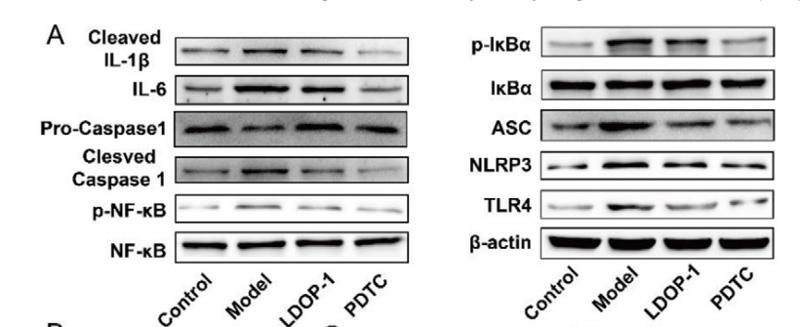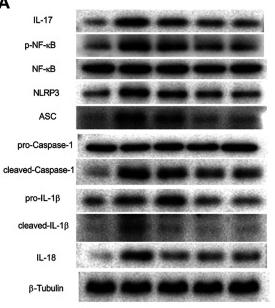Cleaved-Caspase 1 (Ala317), p10 Antibody - #AF4022
| Product: | Cleaved-Caspase 1 (Ala317), p10 Antibody |
| Catalog: | AF4022 |
| Description: | Rabbit polyclonal antibody to Cleaved-Caspase 1 (Ala317), p10 |
| Application: | WB IHC IF/ICC |
| Cited expt.: | WB, IHC, IF/ICC |
| Reactivity: | Human, Mouse, Rat |
| Prediction: | Pig, Bovine, Horse, Rabbit, Dog |
| Mol.Wt.: | 10kD,45kD; 45kD(Calculated). |
| Uniprot: | P29466 |
| RRID: | AB_2845464 |
Product Info
*The optimal dilutions should be determined by the end user. For optimal experimental results, antibody reuse is not recommended.
*Tips:
WB: For western blot detection of denatured protein samples. IHC: For immunohistochemical detection of paraffin sections (IHC-p) or frozen sections (IHC-f) of tissue samples. IF/ICC: For immunofluorescence detection of cell samples. ELISA(peptide): For ELISA detection of antigenic peptide.
Cite Format: Affinity Biosciences Cat# AF4022, RRID:AB_2845464.
Fold/Unfold
CASP-1; CASP1; CASP1_HUMAN; Caspase 1; Caspase-1 subunit p10; ICE; IL-1 beta-converting enzyme; IL-1BC; IL1 beta converting enzyme; IL1B convertase; Interleukin 1 beta convertase; Interleukin 1B converting enzyme; Interleukin-1 beta convertase; Interleukin-1 beta-converting enzyme; p45;
Immunogens
The antiserum was produced against synthesized peptide derived from human Caspase 1.
Expressed in larger amounts in spleen and lung. Detected in liver, heart, small intestine, colon, thymus, prostate, skeletal muscle, peripheral blood leukocytes, kidney and testis. No expression in the brain.
- P29466 CASP1_HUMAN:
- Protein BLAST With
- NCBI/
- ExPASy/
- Uniprot
MADKVLKEKRKLFIRSMGEGTINGLLDELLQTRVLNKEEMEKVKRENATVMDKTRALIDSVIPKGAQACQICITYICEEDSYLAGTLGLSADQTSGNYLNMQDSQGVLSSFPAPQAVQDNPAMPTSSGSEGNVKLCSLEEAQRIWKQKSAEIYPIMDKSSRTRLALIICNEEFDSIPRRTGAEVDITGMTMLLQNLGYSVDVKKNLTASDMTTELEAFAHRPEHKTSDSTFLVFMSHGIREGICGKKHSEQVPDILQLNAIFNMLNTKNCPSLKDKPKVIIIQACRGDSPGVVWFKDSVGVSGNLSLPTTEEFEDDAIKKAHIEKDFIAFCSSTPDNVSWRHPTMGSVFIGRLIEHMQEYACSCDVEEIFRKVRFSFEQPDGRAQMPTTERVTLTRCFYLFPGH
Predictions
Score>80(red) has high confidence and is suggested to be used for WB detection. *The prediction model is mainly based on the alignment of immunogen sequences, the results are for reference only, not as the basis of quality assurance.
High(score>80) Medium(80>score>50) Low(score<50) No confidence
Research Backgrounds
Thiol protease that cleaves IL-1 beta between an Asp and an Ala, releasing the mature cytokine which is involved in a variety of inflammatory processes. Important for defense against pathogens. Cleaves and activates sterol regulatory element binding proteins (SREBPs). Can also promote apoptosis. Upon inflammasome activation, during DNA virus infection but not RNA virus challenge, controls antiviral immunity through the cleavage of CGAS, rendering it inactive. In apoptotic cells, cleaves SPHK2 which is released from cells and remains enzymatically active extracellularly.
The two subunits are derived from the precursor sequence by an autocatalytic mechanism.
Cytoplasm. Cell membrane.
Expressed in larger amounts in spleen and lung. Detected in liver, heart, small intestine, colon, thymus, prostate, skeletal muscle, peripheral blood leukocytes, kidney and testis. No expression in the brain.
Belongs to the peptidase C14A family.
Research Fields
· Cellular Processes > Cell growth and death > Necroptosis. (View pathway)
· Human Diseases > Neurodegenerative diseases > Amyotrophic lateral sclerosis (ALS).
· Human Diseases > Infectious diseases: Bacterial > Salmonella infection.
· Human Diseases > Infectious diseases: Bacterial > Pertussis.
· Human Diseases > Infectious diseases: Bacterial > Legionellosis.
· Human Diseases > Infectious diseases: Viral > Influenza A.
· Organismal Systems > Immune system > NOD-like receptor signaling pathway. (View pathway)
· Organismal Systems > Immune system > Cytosolic DNA-sensing pathway. (View pathway)
References
Application: WB Species: mouse Sample: Liver
Application: IF/ICC Species: Mouse Sample: hippocampus
Application: WB Species: Human Sample: GES-1 cells
Application: IF/ICC Species: Human Sample: THP-1 cells
Restrictive clause
Affinity Biosciences tests all products strictly. Citations are provided as a resource for additional applications that have not been validated by Affinity Biosciences. Please choose the appropriate format for each application and consult Materials and Methods sections for additional details about the use of any product in these publications.
For Research Use Only.
Not for use in diagnostic or therapeutic procedures. Not for resale. Not for distribution without written consent. Affinity Biosciences will not be held responsible for patent infringement or other violations that may occur with the use of our products. Affinity Biosciences, Affinity Biosciences Logo and all other trademarks are the property of Affinity Biosciences LTD.











![Fig. 4. OxLDL induces VSMCs pyroptosis. (A) Lipid uptake determined by Dil-oxidized low-density lipoprotein (Dil-OxLDL). Mice VSMCs were treated with different
concentrations of Dil-OxLDL for 24 h. DAPI is blue. VSMCs were treated with varies concentration of human OxLDL for 24 h to determine cell pyroptosis (B–H).
Quantification of PI-positive cells (B) and LDH activity (C). (D) Representative images of TUNEL staining (red) and caspase-1 immunofluorescence staining (green).
(E) Quantification of caspase-1 activity in cell lysates. (F) Quantification of IL-1β release to supernatants by enzyme-linked immunosorbent assay. (G) Representative
immunoblots of pyroptotic indicators (cleaved IL-1β, pro-IL-1β, pro-caspase-1 [pro-casp-1], cleaved caspase-1 p20 [active caspase-1 subunit], NLRP3 and ASC) and
apoptotic index [cleaved caspase-3 and pro-caspase-3 (left)]. β-tubulin served as loading control. Quantitative analyses of p20 and cleaved IL-1β from 3 independent
experiments were shown (right). (H) Representative blots of co-immunoprecipitation for NLRP3 and ASC to indicate NLRP3 inflammasome activation (left).
Quantitative analyses of NLRP3 from 5 independent experiments were shown (right). LPS served as positive control. Data are presented as means ± SEM.
*p < 0.05, **p < 0.001, one-way ANOVA with Turkey's multiple comparisons test Cleaved-Caspase 1 (Ala317), p10 Antibody - Fig.](http://img.affbiotech.cn/images/cited_image/202207/cite-wx-54-1658977738.jpg)





































